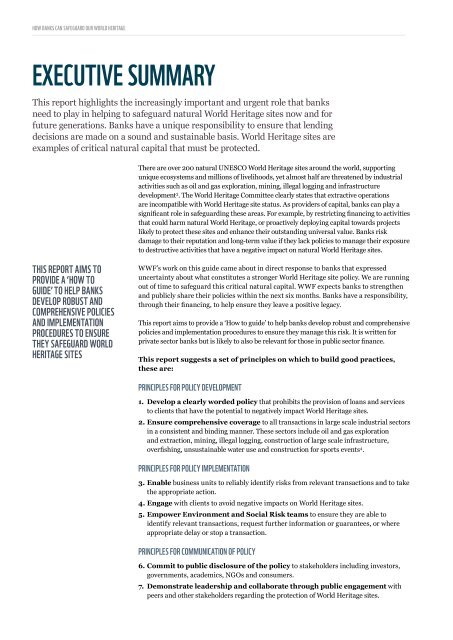Bios-Cons-Nat-Pro-155
You also want an ePaper? Increase the reach of your titles
YUMPU automatically turns print PDFs into web optimized ePapers that Google loves.
HOW BANKS CAN SAFEGUARD OUR WORLD HERITAGE<br />
7<br />
EXECUTIVE SUMMARY<br />
This report highlights the increasingly important and urgent role that banks<br />
need to play in helping to safeguard natural World Heritage sites now and for<br />
future generations. Banks have a unique responsibility to ensure that lending<br />
decisions are made on a sound and sustainable basis. World Heritage sites are<br />
examples of critical natural capital that must be protected.<br />
There are over 200 natural UNESCO World Heritage sites around the world, supporting<br />
unique ecosystems and millions of livelihoods, yet almost half are threatened by industrial<br />
activities such as oil and gas exploration, mining, illegal logging and infrastructure<br />
development 3 . The World Heritage Committee clearly states that extractive operations<br />
are incompatible with World Heritage site status. As providers of capital, banks can play a<br />
significant role in safeguarding these areas. For example, by restricting financing to activities<br />
that could harm natural World Heritage, or proactively deploying capital towards projects<br />
likely to protect these sites and enhance their outstanding universal value. Banks risk<br />
damage to their reputation and long-term value if they lack policies to manage their exposure<br />
to destructive activities that have a negative impact on natural World Heritage sites.<br />
THIS REPORT AIMS TO<br />
PROVIDE A ‘HOW TO<br />
GUIDE’ TO HELP BANKS<br />
DEVELOP ROBUST AND<br />
COMPREHENSIVE POLICIES<br />
AND IMPLEMENTATION<br />
PROCEDURES TO ENSURE<br />
THEY SAFEGUARD WORLD<br />
HERITAGE SITES<br />
WWF’s work on this guide came about in direct response to banks that expressed<br />
uncertainty about what constitutes a stronger World Heritage site policy. We are running<br />
out of time to safeguard this critical natural capital. WWF expects banks to strengthen<br />
and publicly share their policies within the next six months. Banks have a responsibility,<br />
through their financing, to help ensure they leave a positive legacy.<br />
This report aims to provide a ‘How to guide’ to help banks develop robust and comprehensive<br />
policies and implementation procedures to ensure they manage this risk. It is written for<br />
private sector banks but is likely to also be relevant for those in public sector finance.<br />
This report suggests a set of principles on which to build good practices,<br />
these are:<br />
PRINCIPLES FOR POLICY DEVELOPMENT<br />
1. Develop a clearly worded policy that prohibits the provision of loans and services<br />
to clients that have the potential to negatively impact World Heritage sites.<br />
2. Ensure comprehensive coverage to all transactions in large scale industrial sectors<br />
in a consistent and binding manner. These sectors include oil and gas exploration<br />
and extraction, mining, illegal logging, construction of large scale infrastructure,<br />
overfishing, unsustainable water use and construction for sports events 4 .<br />
PRINCIPLES FOR POLICY IMPLEMENTATION<br />
3. Enable business units to reliably identify risks from relevant transactions and to take<br />
the appropriate action.<br />
4. Engage with clients to avoid negative impacts on World Heritage sites.<br />
5. Empower Environment and Social Risk teams to ensure they are able to<br />
identify relevant transactions, request further information or guarantees, or where<br />
appropriate delay or stop a transaction.<br />
PRINCIPLES FOR COMMUNICATION OF POLICY<br />
6. Commit to public disclosure of the policy to stakeholders including investors,<br />
governments, academics, NGOs and consumers.<br />
7. Demonstrate leadership and collaborate through public engagement with<br />
peers and other stakeholders regarding the protection of World Heritage sites.<br />
AFRICAN ELEPHANTS IN THE MASAI MARA RESERVE, KENYA.<br />
© GREG ARMFIELD / WWF-UK<br />
Mountain gorilla (Gorilla beringei beringei)<br />
silverback watching through forest,<br />
Virunga Mountains, Volcanoes NP, Rwanda<br />
© NATUREPL.COM / ANDY ROUSE / WWF


